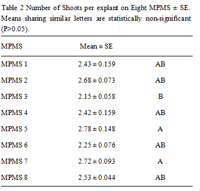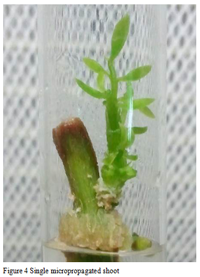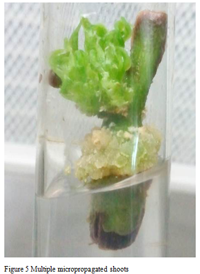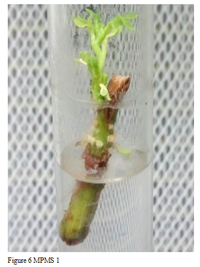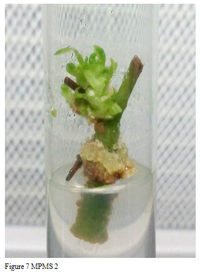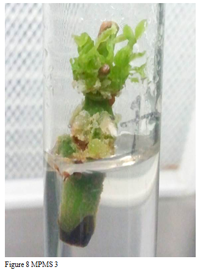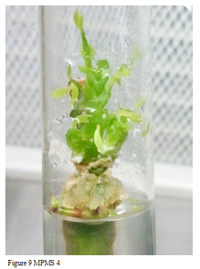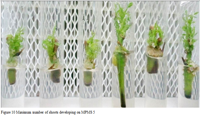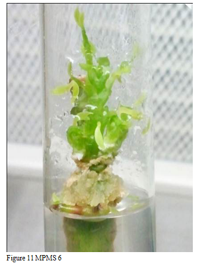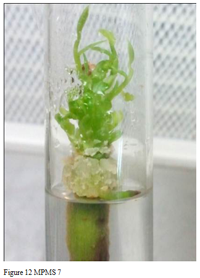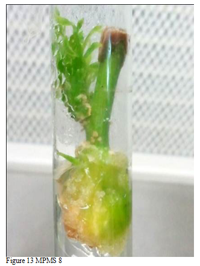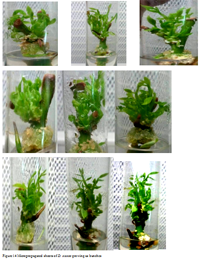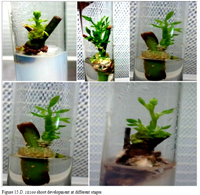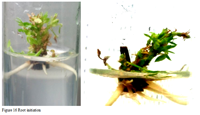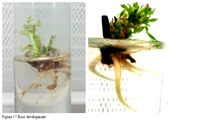Research Ariticle
Development of Source Independent Micropropagation System in Dalbergia sissoo Roxb, as a basis for Germplasm Conservation and Disease Free Plants Production 
2 Department of Plant Breeding and Genetics, University of Agriculture Faisalabad, Pakistan
 Author
Author  Correspondence author
Correspondence author
Molecular Plant Breeding, 2016, Vol. 7, No. 15 doi: 10.5376/mpb.2016.07.0015
Received: 10 Dec., 2015 Accepted: 19 Feb., 2016 Published: 19 Feb., 2016
Zaidi S.A., Ijaz S., Iqba A., Khan, and Rana I.A., 2016, Development of Source Independent Micropropagation System in Dalbergia sissoo Roxb, as a Basis for Germplasm Conservation and Disease Free Plants Production, Molecular Plant Breeding,7(10):1-12 (doi: 10.5376/mpb.2016.07.0015)
Plant micropropagation has becoming an imperative strategy at commercial level that provides large number of plants in less time and space. In woody trees, micropropagation is more tedious and cumbersome process than other crop plants. Less success rate in tree micropropagation has been reported in literature. Therefore in this study, expedite, reproducible and source independent micropropagation protocol was developed in Dalbergia sissoo (Shisham) that is an economically important timer yielding tree with medicinal values. For this purpose, eight micropropagation media were studied with various combination of BAP (benzylaminopurine) and IAA (indole acetic acid). Auxially and epicormic shoots of Dalbergia sissoo having at least one nodal bud were used as explants. We studied the impact of these media combination and explant types on micropropagation. We found MPMS5 is the best medium combination that gave maximum number of shoots (2.78 shoots per explant) followed by MPMS7. This selected media combination can be used for Dalbergia sissoo micropropagation as a routine work. Similarly rooting media combinations were also studied for the best root induction in micropropagated shoots of Dalbergia sissoo but little success had been achieved.
Introduction
Urbanization and deforestation are the pivotal forces those bring negative stress to natural resources. Evolution of problems relating to these forces is basically due to rapid increase in human population. Ecosystem in general and habitats of endangered species in particular are affected by these situations. Many industries depend upon the continuous supply of wood, can not totally rely on natural sources, therefore efforts should be done to find new ways to fulfill their demand for timber (Jain, 1997; Tzfira et al., 1998). Conventional propagation through cuttings and suckers do not provide the required plant material to support the increasing timber demand due to various factors (Ali et al., 2005). Therefore the focuses should be on replacing these conventional means with modern in-vitro techniques. Biotic and abiotic factors also affect trees that result in declined tree populations (Rehman et al., 2012).
Development of resistant material against various natural calamities will reduce supply-demand strain and will be more beneficial for farmers as well for industries (Minocha and Jain, 2000). Different conventional and non conventional strategies have been employed to multiply the resistant plants in huge number (Pradhan et al., 1998). Micropropagation facilitates multiplication from limited mother stock, keep product uniformity, not dependent upon season and many other agronomic advantages (Kunisaki et al., 2003). Micro- propagation in economic tree species is also now becoming an emerging tool and requirement of this modern era.
Dalbergia sissoo Roxb is a very important timber yielding perennial tree found throughout IndoPak subcontinent. It has been used for forestation in most parts of the subcontinent for years (Priyanka et al., 2012). It has great economic importance as its wood is used in making furniture, agricultural tools, used as fuel and also has some medicinal value. At least half a dozen fungal diseases are reported in IndoPak. But in last few years this tree has been badly affected by a disease called; Shisham decline or dieback, that was announced as an epidemic for Shisham all over the Pakistan in 1998 (Naz, 2002; Bajwa et al., 2003). Die-back disease of Shisham was first time observed and reported in Nepal. This disease has now been reached epidemic proportion in Bangladesh and other countries of South Asia. This disease is characterized by wilting and subsequent loss of side branches, leading to so called stagheadness.
To combat with these problems, tissue culture and biotechnological approaches have been employing for many decades. Micropropagation of woody trees has been attempted many times but still is not emerged as routine. In D. sissoo, during the last couple of years, several attempts have been done to develop efficient micropropagation. Impact of various explants and media types on micropropagation have been studied which resulted in small success but a breakthrough is still to come which will make D. sissoo micropropagation a routine work. Therefore in this study, an effective and source independent micropropagation protocol was established that would be a milestone for all in vitro studies in D. sissoo.
1 Results
Tissue culture has key role in providing rapid and healthy plant multiplication techniques that are crucial for plant species facing certain biotic and abiotic stresses in nature. Various diseases, especially dieback, are badly affecting our natural Shisham resources; hence establishment of an efficient micropropagation protocol is necessary. This study addresses the development of source independent micropropagation protocol for D. sissoo. For this purpose two explant sources i.e. Axillary and epicormic shoots, were selected and micropropagation response was evaluated on different media combinations.
1.1 Micropropagation Response of Shisham (Dalbergia sissoo)
For establishing micropropagation in D. sissoo eight different micropropagation media (MPM) combinations supplemented with varying con- centrations of BAP and IAA were studied. The data was collected in the form of number of shoots obtained per explant and ANOVA table was constructed.
The analysis of variance table (Table 1) depicts the considerable significant variation among media combinations. MPMS 5 gave maximum number of 2.78 shoots per explant (Figure 1) followed by MPMS 7 and MPMS 2 on which 2.72 and 2.68 average shoots per explant were obtained respectively. The other five combinations showed a comparatively low response for shoot induction. Among which MPMS 3 showed the lowest response with 2.15 mean numbers of shoots per explant (Table 2 and Figure 1).
|
Table 1 Analysis of variance table for micropropagation of D. sissoo on different media combinations |
|
Figure 1 Mean number of shoots per each media combination. MPMS 5 showing maximum micropropagation response followed by MPMS 7 & MPMS 2. Lowest response of MPMS 3 is also shown |
|
Table 2 Number of Shoots per explant on Eight MPMS ± SE. Means sharing similar letters are statistically non-significant (P>0.05) |
Both explant sources responded well for micropropagation, epicormic shoots giving 2.53 shoots per explant and Axillary shoots giving 2.46 shoots per explant. On these micropropagation media, single shoots as well as bunch of shoots/multiple shoots were observed (Figure 2, Figure 3, Figure 4, & Figure 5). But the media to explant interaction represented non-significant results, which means the micropropagation response does not depend upon the explant source (Response of different micro- propagation media is shown in Figure 6, Figure 7, Figure8, Figure 9, Figure 10, Figure 11, Figure 12 & Figure 13). A common thing that had been seen was the formation of calli from explants at media-explant junction. The callus formation was seen to be increasing with the increase in BAP concentration, so MPMS 4 & MPMS 8 giving maximum callus. Different shoot development stages are shown in Figure 14 & Figure 15.
|
Figure 2 Bud sprouting |
|
Figure 3 Shoot development started |
|
Figure 4 Single micropropagated shoot |
|
Figure 5 Multiple micropropagated shoots |
|
Figure 6 MPMS 1 |
|
Figure 7 MPMS 2 |
|
Figure 8 MPMS 3 |
|
Figure 9 MPMS 4 |
|
Figure 10 Maximum number of shoots developing on MPMS 5 |
|
Figure 11 MPMS 6 |
|
Figure 12 MPMS 7 |
|
Figure 13 MPMS 8 |
|
Figure 14 Micropropagated shoots of D. sissoo growing as bunches |
|
Figure 15 D. sissoo shoot development at different stages |
1.2 Root Induction from Micropropagated Shoots of D. sissoo
For root induction three rooting media were studied. Well developed micropropagated shoots were shifted to root induction media. Root initiation from few micropropagated shoots were started after 20-25 days of shifting on root induction media (Figure 16 & Figure 17). Of these, one rooting medium; RM2 (Rooting medium 2) was already reported by Thirunavoukkarasu et al., 2010 and we used it as control. In Shisham root induction of in vitro regenerated shoots is very poor and in our study we attempted this challenge but very little success was achieved in case of rooting.
|
Figure 16 Root initiation |
|
Figure 17 Root development |
2 Discussion
Shisham is a deciduous tree of great economic importance but currently it has badly been affected by certain diseases in which Shisham dieback is on top. So there was a need of an efficient micropropagation protocol that could be a milestone in further tissue culture studies of Shisham. Due to the strong heterozygosity of trees, their production using seeds or other conventional means is not appropriate, if one wants to conserve the characteristics of a desired tree species (Das and Mitra, 1990). So in almost all vegetatively propagated species, the establishment of efficient tissue culture system has been the foundation of mass scale planting material and production of disease free and high quality plants. It is essential for successful reforestation programs and affluent forest management as well.
In current study, two types of explants viz epicormic and axillary shoots were used to identify appropriate explants source for optimal response. We observed that micropropagation was independent to explant source. The present investigation also suggested that nodal explants with greenish active buds showed faster multiplication with more number of shoots as compared to nodal explants with brownish buds. Same response was reported in mulberry species as well (Chitra and Padmaja, 1999; Oka and Ohyama, 1975).
The sterilization process has been, more or less as hard to standardize, as was to optimize the adequate media requirements for micropropagation itself. In the sterilization process extra chloroxylenol treatment was done for efficient bacterial and fungal contamination control. Seventy percent ethanol was used pre-treatment to mercuric chloride, again to free the cuttings from any kind of bacterial and fungal contamination. A waxy residue was observed in the rinse water, after treating the explant with ethanol. The elimination of the waxy covering from explant cuttings may cause the explants to become more permeable to the mercuric chloride, causing elevated phenolic exudation.
The micropropagation response was severely affected by pheonolic compounds’ exudation from the sterilized explants. This may occur due to the ooze of anthocyanins and other plant fluids in the culture media from the surface of explant as a result of injury, which explant faced due to the ethanol treatment. The anthocyanins were visible as a browning around the bottom of the cuttings, observed even more easily in comparatively clear media. This was decreased by addition of some auxin, which owing to its cell division property, quickly heals phloem and stops exudation. For this purpose IAA was added as an auxin in every micropropagation medium in addition to BAP. Moreover this problem was overcome by subsequent subculturing of explants that indicated browning. Two-three subcultures were enough to lessen the exudation enough, so it could not affect the shoot formation.
Induction and multiplication of in vitro shoots of almost all woody tree species is easier if the explants are obtained from developing plantlets, generally said to be at juvenile stage and they give superior results than mature explants (George, 1993). The harder the explant cutting became, the longer the sterilization time required and yet harder to control contamination. The bacteria survive longer on hard explants and grow faster under favorable conditions. Soft cuttings grew faster and illustrated less contamination upon initiation, which is why young juvenile explant cuttings with fresh green buds were selected for micropropagation.
Micropropagation is done via different concentrations of various growth regulators, either alone or in combination. Inclusion of auxins and cytokinins in the micropropagation medium greatly influences the shoot formation and development. Generally response and the quality of in vitro cultures are highly influenced by the concentrations and type of nutrients present in the culture media (Niedz and Evens, 2007). Outcome of different micro & macronutrients on growth and number of in vitro culture and micropropagation was investigated by many researchers (Cohen, 1995; Rout et al., 1998; Thirunavoukkarasu and Debata, 2002). In vitro shoot induction in most of the plant species is done using various cytokinins, among which BAP is reported to be the most responsive and efficient (Arumugam and Rao, 1996; Behera et al.,2008; Nayak et al.,2007; Pradhan et al.,1998; Purohit and Dave, 1996). Carelli and Echeverigary, (2002) showed that BAP produces more shoots as compared to Kinetin and 2iP in micropropagation systems. BAP has also been reported the superlative growth regulator for shoot development and multiplication in Shisham by several researchers. Bari et al.,(2008) reported an average 2.2 shoots form callus of Shisham, via combination of 1.5 mg/L BAP + 0.5 mg/L IAA in MS media. Current study also indicated that the addition of BAP, among all cytokinins, proved to be substantially useful for in vitro shoot formation from juvenile buds of Shisham. We obtained a maximum 2.78 number of shoots using MS medium supplemented with 6.6 µM BAP + 1.71 µM IAA. However deformity and abnormal shoot induction was reported as a result of high BAP concentration by some researchers (Carelli and Echeverrigary, 2002).
3 Materials and Methods
3.1 Explants to be used
Material for Shisham micropropagation was collected from the territory of University of Agriculture Faisalabad. Axillary and epicormic shoots were used as explants in this study. Cuttings of 1.5-2.5 cm, each containing at least one nodal bud were used. To the best of our information, Shisham trees that were used as source for getting explants (axillary and epicormic shoots), were wild genotypes to the Faisalabad area, and thus the potential value as clonal material was unidentified.
3.2 Explant sterilization
Explants were thoroughly washed and treated with tween- 20 (7drops/100ml) followed by the treatment with 0.7% Chloroxylenol solution. These explants were dipped in 70% ethanol for 10 seconds and then treated with 0.1 % Mercuric Chloride (HgCl2) solution for 5 minutes. All these operations were done under high axenic conditions in laminar air flow cabinet. Ultra pure water was used for the preparation of all these solutions to be used in sterilization of explants.
3.3 Media preparation and culture conditions
Micropropagation media were prepared by using growth regulators of varying concentrations in addition to MS Salts and sucrose in common. For micropropagation eight media combination with varying levels of IAA and BAP were studied (Table 3). For root induction, half MS media with and without IAA and IBA were used (Table 4). Gellan gum powder was used as solidifying agent and pH was adjusted to 5.8 using NaOH and HCl. Micropropagation media were poured into test tubes that were wrapped by using polypropylene sheets and then autoclaved at 121°C, 15 psi for 20 minutes. Culturing of explants on micropropagation media were done under aseptic conditions in laminar air flow hood. These cultures were incubated and maintained in controlled conditions at 25 ± 2°C for 16/8 hrs light/dark period.
|
Table 3 Micropropagation Media (MPM) for Dalbergia sissoo Roxb |
|
Table 4 Root induction Media (RIM) for Dalbergia sissoo Roxb |
3.4 Data collection and Statistical analysis
Data of micropropagation were collected in the form of number of shoots per explant. Analysis of Variance table was made among different media combinations and explant sources. Experiment was designed under CRD in factorial design and data was collected and analyzed (Steel and Torrey, 1982).
Ali A., Rizwan M., Abdul M., Saleem A., and Naveed N.H., 2012, Effect of media type and explants source on micropropagation of Dalbergia sissoo: A tree of medicinal importance, Journal of Medicinal Plants Research, 6(9): 1742-1751
Arumugam A. and Rao M.V., 1996, In vitro production of plants from cotyledonary node cultures of Aegle marmelos (L.), Adv. Plant Sci, 9(2): 181-186
Bajwa R., Javid A., and Shah M.B.M., 2003a, Extent of Shisham (Dalbergia sissoo Roxb.) decline in Sialkot, Gujranwala, Lahore and Sargodha Districts, Mycopath. 1(1): 1–5
Bajwa, R., A. Javaid, J.H. Mirza and N. Akhtar. 2003b. Chemical control of wilt in shisham (Dalbergia sissoo Roxb.) Mycopath, 1(2): 111-113
Bari M.A., Ferdaus K.M.K.B., and Hossain M.J., 2008, Callus induction and plantlet regeneration from in vivo nodal and intermodal segments and shoot tip of Dalbergia sissoo Robx, J. bio-sci, 16: 41-48
Behera P.R., Nayak P., Thirunavoukkarasu M., and Sahoo S.B., 2008, Plant regeneration of Gmelina arborea Roxb. from cotyledonary node explants, Indian J. Plant Physiol, 13(3):258-265
Carelli B.P., and Echeverrigary S., 2002, An improved system for the in vitro propagation of rose cultivars, Sci. Hort, 92(1): 64–74
http://dx.doi.org/10.1016/S0304-4238(01)00280-1
Chitra V.D.S., and Padmaja G., 1999, Clonal propagation of mulberry (Morus indicaL. cultivar M-5) through in vitro culture of nodal explants, Sci. Hort, 80(3): 289-298
http://dx.doi.org/10.1016/S0304-4238(98)00252-0
Cohen D., 1995, The culture medium, Acta Hort, 393(2): 15-24
http://dx.doi.org/10.17660/ActaHortic.1995.393.2
George E.F., 1993, Plant propagation by tissue culture, Part 1 The Technology, 2nd Ed, Exegetics Ltd., Edington
Jain S.M., 1997, Biotechnology of industrially important tree species in developing countries, Plant Biotechnology and Plant Genetic Resources for Sustainability and Productivity (eds. K.N. Watanabe and E. Pehu), 227-238
Kunisaki J., Araki A., and Sagawa Y., 2003, Micropropagation of ‘Awa (Kava, Piper methysticum), College of Tropical Agriculture and Human Resources (CTAHR), http://www.ctahr.hawaii.edu
Minocha and Jain S.M., 2000, Tissue culture of woody plants and its relevance to molecular biology, Molecular Biology of Woody Plants, 1: 315-339
Nayak P., Behera P.R., and Thirunavoukkarau M., 2007, High frequency plantlet regeneration from cotyledonary node cultures of Aegle marmelos (L.) Corr. In vitro Cell Dev. Biol. Plant, 43:231-236
http://dx.doi.org/10.1007/s11627-006-9013-6
Naz S.I., 2002, The vanishing shisham tree, The Daily Dawn, 4 January 2002, Lahore, Pakistan
Ndoye M., Diallo I., and Dia Y.K.G., 2003, In vitro multiplication of the semi-arid forest tree, Balanites aegyptiaca(L.) Del. Afr. J. Biotech, 2(11): 421-424
http://dx.doi.org/10.5897/AJB2003.000-1084
Niedz R.P., and Evens T.J., 2007, Regulation of plant tissue growth by mineral nutrition, In vitro Cell Dev, Biol. Plant 43: 370-381
http://dx.doi.org/10.1007/s11627-007-9062-5
Oka S., and Ohyama K., 1975, Studies on in vitro culture of excised bud in mulberry tree, Effect of growth substances on the development of shoots from bud, J. Seric. Sci, Jpn. 44: 444-450
Pattnaik S., Pradhan C., Naik S.K., and Chand P.K., 2000, Shoot organogenesis and plantlet regeneration from hypocotyl-derived cell suspensions of a tree legume, Dalbergia sissoo roxb, In Vitro Cellular & Developmental Biology, 36(5): 407-411
http://dx.doi.org/10.1007/s11627-000-0073-8
Pradhan C., Kar S., Pattnail S. and Chand P.K., 1998, Propagation of Dalbergia sissoo Roxb, through in vitro shoot proliferation from cotyledonary nodes, Plant Cell Rep, 18(1): 122-126
http://dx.doi.org/10.1007/s002990050543
Priyanka B., Chaubey O.P., and Singha P.K., 2012, Biomass Accumulation and Carbon Sequestration in Dalbergia sissoo Roxb, International Journal of Bio-Science and Bio-Technology, 4(3): 29-44
Purohit S.D. and Dave A., 1996, Micropropagation of Sterculia urens Roxb, An endangered tree species, Plant Cell Rep, 15(9): 704-706
http://dx.doi.org/10.1007/BF00231929
Rehman H.M., Rana I.A., Ijaz S., Mustafa G., Joyia F.A., Khan I.A. and Pijut P.M., 2012, In vitro Regeneration of Dalbergia sissoo Roxb and the Potential for Genetic Transformation, Not Bot Horti Agrobo, 40(2): 140-147
Rout G.R., Das P., Goel S., and Raina S.N., 1998, Determination of genetic stability of micropropagated plants of ginger using Random Amplified Polymorphic DNA (RAPD) markers, Bot. Bull Acad, Sin, 39: 23-27
Steel R.G.D., and Torrie J.H., 1986, Principles and Procedures of Statistics, McGraw Hill Book Co. New York, USA, 187 p.
Thirunavoukkarasu M., and Debata B.K., 2002, Clonal propagation of Enterolobium cyclocarpum (Jacq.) Griseb. through in vitro culture of hypocotyl explants, Proc. of ]Utilization of Bioresources, Allied Publishers pp. 391-396
Thirunavoukkarasu M., Panda P.K., Nayak P., Behera P.R., and Satpathy G.B., 2010, Effect of media type and explant source on micropropagation of Dalbergia sissoo Roxb, - An important multipurpose forest tree, IRJPS, 1(6): 155-162
Tzfira T., Zuker A., and Altman A., 1998, Forest tree biotechnology: genetic transformation and its application to hture forests, Trends in Biotechnology, 16(10): 439-446
. PDF(1083KB)
. FPDF
. HTML
. Online fPDF
Associated material
. Readers' comments
Other articles by authors
. Shan-e-Ali Zaidi
. Siddra Ijaz
. Azeem Iqba Khan
. Iqrar Ahmad Rana
Related articles
. Dalbergia sissoo
. Micropropagation
. Shisham
. Tissue culture
. Woody tree
Tools
. Email to a friend
. Post a comment

.png)
